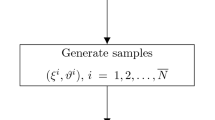Abstract
We study a planning problem associated with networks for private line services. In these networks, demands are known to exhibit considerable variability, and as such, they should be treated as random variables. The proposed planning model is a two-stage stochastic linear program (SLP) with recourse. Due to the enormous size of the deterministic equivalent, we choose a sampling based algorithm calledstochastic decomposition (SD). For very large-scale SLPs, such as the ones solved in this application, SD provides an effective methodology. The model presented in this paper is validated by using a detailed simulation of the network. We report results with a network that has 86 demand pairs, 89 links and 706 potential routes.
Similar content being viewed by others
References
G.R. Ash, R.H. Cardwell and R.P. Murray, Design and optimization of networks with dynamic routing, Bell Syst. Tech. J. 60(1981)1787–1820.
J.F. Benders, Partitioning procedures for solving mixed variables programming problems, Numerische Mathematik 4(1962)238–252.
W.H. Cameron, J. Regnier, P. Galloy and A.M. Savoi, Dynamic routing for intercity telephone networks,Proc. 10th Int. Teletraffic Congress, Montreal, 1983.
G.B. Dantzig and P.W. Glynn, Parallel processors for planning under uncertainty, Ann. Oper. Res. 22(1990)1–21.
R.D. Doverspike and V. Jha, Comparison of routing methods for DCS-switched networks, Interfaces, Special Issue on Telecommunications, 23(1993)21–34.
G.D. Eppen, R.K. Martin and L. Schrage, A scenario approach to capacity planning, Oper. Res. 37(1989)517–527.
Y. Ernoliev, Stochastic quasigradient methods, in:Numerical Techniques for Stochastic Optimization, eds. Y. Ermoliev and R.J-B. Wets (Springer, Berlin, 1988).
A. Gaivoronski, Implementation of stochastic quasigradient methods, in:Numerical Techniques for Stochastic Optimization, eds. Y. Ermoliev and R.J-B. Wets (Springer, Berlin, 1988).
J.L. Higle and S. Sen, Stochastic decomposition: An algorithm for stage linear programs with recourse, Math. Oper. Res. 16(1991)650–669.
J.L. Higle and S. Sen, Statistical verification of optimality conditions, Ann. Oper. Res. 30(1991) 215–240.
P.S. Horn, Modeling the error distribution for special-services forecasts, Bell Laboratories Technical Memorandum 83-54113-3 (1983).
G. Infanger, Monte Carlo (importance) sampling within a Benders decomposition algorithm for stochastic linear programs, Ann. Oper. Res. 39(1992)69–95.
A. Ionescu-Graff, A sequential projection algorithm for special services demand, Bell Syst. Tech. J. 61(1982)34–66.
K.C. Kiwiel,Methods of Descent for Nondifferentiable Optimization, Lecture Notes in Mathematics 1133 (Springer, Berlin, 1985).
K.R. Krishnan and T.J. Ott, State-dependent routing for telephone traffic: Theory and results,25th IEEE Control and Decision Conf., Athens, Greece, 1986.
K.R. Krishnan and T.J. Ott, Forward looking routing: A new state dependent routing scheme,Proc. 12th Int. Teletraffic Congress, Torino, Italy, 1988.
F.H. Murphy, S. Sen and A.L. Soyster, Electric utility capacity expansion with uncertain load forecasts, HE Trans. 14(1982)52–59.
K.G. Murty,Linear Programming (Wiley, 1984).
S. Sen, J. Mai and J.L. Higle, Solution of large scale stochastic programs with stochastic decomposition algorithms, in:Large Scale Optimization: The State of the Art, eds. W. Hager, D. Hearn and P. Pardalos (Kluwer, 1993), to be published.
D.R. Smith, A model for special-service circuit activity, Bell Syst. Tech. J. 62(1983)2911–2934.
S. Uriasiev, Adaptive stochastic quasigradient methods, in:Numerical Techniques for Stochastic Optimization, eds. Y. Ermoliev and R.J-B. Wets (Springer, Berlin, 1988).
R. Van Slyke and R.J-B. Wets, L-shapes linear programs with application to optimal control and stochastic programming, SIAM J. Appl. Math. 17(1969)638–663.
R.J-B. Wets, Stochastic programming: Solution techniques and approximation schemes, in:Mathematical Programming: The State of the Art, 1982, eds. A. Bachem, M. Groetschel and B. Korte (Springer, Berlin, 1982) pp. 566–603.
Author information
Authors and Affiliations
Additional information
This work was supported in part by Grant No. NSF-DDM-9114352 from the National Science Foundation.
Rights and permissions
About this article
Cite this article
Sen, S., Doverspike, R.D. & Cosares, S. Network planning with random demand. Telecommunication Systems 3, 11–30 (1994). https://doi.org/10.1007/BF02110042
Received:
Revised:
Issue Date:
DOI: https://doi.org/10.1007/BF02110042




